How Often Should You Mow Your Lawn in Indiana—And Why It Matters

Is your lawn looking a little wild—or worse, patchy and stressed? In Indiana, where cool-season grasses dominate and weather patterns can swing wildly between weeks, the frequency and technique of your mowing routine matter more than you might think.
If you’ve ever wondered how often should I mow my lawn in Indiana? or why does it look worse after a cut?, this guide breaks down exactly what you need to know to keep your grass thick, green, and resilient year-round.
Quick Answer: How Often Should You Mow in Indiana?
In spring and fall, mow your lawn every 5 to 7 days to keep up with rapid growth.
During summer heat, stretch your schedule to every 7 to 10 days, and raise your mower blade to 3 to 3.5 inches to protect the roots and retain moisture.
Never remove more than one-third of the grass height at a time—doing so causes stress and weakens the lawn.
What Is the Ideal Mowing Height and Frequency?
Most Indiana lawns are planted with cool-season grasses, such as tall fescue, Kentucky bluegrass, or perennial ryegrass. These varieties grow quickly in spring and fall, slow down during summer, and benefit from strategic height adjustments throughout the year.
The optimal mowing height is between 3 and 3.5 inches, especially during the summer. Taller grass shades the soil, reduces evaporation, and helps protect root systems from heat stress. If you cut too short, especially in July and August, you’re more likely to end up with scorched spots and increased weed pressure.
Matching your mowing frequency to the season is equally important:
- Early spring and late fall: Grass grows fast, so mow every 5–7 days.
- Summer: Growth slows under heat stress, so cut every 7–10 days and raise your blade height.
- After fertilizing or heavy rain: Grass may surge in growth—monitor and adjust as needed.
Why Proper Mowing Matters for Indiana Lawns
Think mowing is just about appearances? Think again. When done right, mowing acts like a natural conditioning routine for your lawn.
Stronger Roots, Thicker Turf
Frequent, proper mowing stimulates denser turf growth, which naturally crowds out weeds. It also encourages roots to grow deeper—essential for handling Indiana’s fluctuating moisture levels.
Better Resilience to Heat and Drought
Taller grass blades provide shade for the soil beneath, helping it retain moisture during hot spells. Well-maintained turf is also less likely to show signs of heat stress, like yellowing or browning.
Lower Risk of Disease and Weeds
Mowing with sharp blades and proper frequency reduces thatch buildup, improves air circulation, and lowers the chance of fungal disease. Thick turf also creates a natural barrier to weed invasion, saving you time and herbicide costs down the line.
How to Develop a Mowing Schedule (Step-by-Step)
You don’t need to overcomplicate things, but building a consistent mowing schedule helps your lawn thrive across Indiana’s seasons.
- Identify Your Grass Type
Cool-season grasses dominate in Indiana, but know whether your lawn includes fescue, bluegrass, or ryegrass. This can affect how fast it grows and how it responds to mowing height. - Monitor Weekly Growth
Use a ruler or turf gauge once a week to measure blade height. If the grass has grown more than one-third above your set mowing height, it’s time to mow. - Adjust Blade Height Seasonally
Spring and fall: Keep blades at about 3 inches.
Summer: Raise to 3.5 inches to reduce moisture loss. - Use a Tracking Method That Works for You
Whether it's a lawn app, calendar, or basic reminder on your phone, tracking helps keep your cuts consistent—especially if rainfall or fertilization changes your lawn’s growth rate. - Skip Mowing After Heavy Rain
Wet grass doesn’t cut cleanly. Wait until the soil is dry and the blades stand upright to avoid ruts, clumps, and fungal risk.
Reel vs. Rotary Mowers: What’s Best for Indiana Lawns?
Choosing the right mower makes a difference, especially if you want clean, even cuts without damaging turf.
Reel Mowers
These use a scissor-like motion that delivers an ultra-clean cut, making them great for dense, fine grasses on small, flat lawns. The downside? They require more maintenance and sharpening.
Rotary Mowers
Most homeowners in Indiana rely on rotary mowers. They’re versatile, easier to maintain, and handle medium to large lawns and uneven ground well. While the cut isn’t as clean as a reel mower, it’s more than adequate for typical residential use.
Bottom line: For most Indiana yards, a rotary mower is the better fit—unless you’re going for a golf-course look and don’t mind the extra upkeep.
Preventing Common Mowing Mistakes
Even well-meaning homeowners can set back their lawn health with just a few bad habits. Here’s what to avoid:
- Cutting Too Short (Scalping): Never remove more than a third of the grass blade in one mow. It shocks the turf, weakens the root system, and invites weed growth.
- Mowing Wet Grass: Wet blades don’t cut cleanly. Mowing while wet also risks soil compaction and disease spread.
- Dull Blades: If your mower blade hasn’t been sharpened this season, it’s probably tearing the grass instead of slicing it. Torn blades brown at the tips and become disease-prone.
- Same Pattern Every Time: Always mowing in the same direction compacts the soil and creates ruts. Switch up your path to encourage upright growth and even coverage.
- Too Fast, Too Low: Speeding through a mow can leave jagged, uneven results—and scalping dips in your yard. Take your time and use a consistent pace.
When to Call a Professional Lawn Care Service
Sometimes, even with the best intentions and consistent mowing, your lawn still isn’t thriving. If you're dealing with brown patches, uneven growth, or simply don’t have the time to maintain a weekly schedule, it might be time to bring in expert help.
You might benefit from a professional lawn mowing service if:
- Your grass keeps browning despite regular mowing
- You're struggling to keep a consistent mowing routine
- Your mower isn’t cutting cleanly or leaves the lawn uneven
- You’re also facing issues with weeds, grubs, or fungal disease
At NatureScape Services, we build custom lawn care plans tailored to Indiana lawns—from mowing and fertilization to weed and pest control. Our team understands local grasses, seasonal stress points, and what it takes to keep your yard healthy through every season.
Want a thicker, greener lawn without the weekend hassle?
Schedule a free consultation with NatureScape Services and let us handle the mowing and more—so you can enjoy the results without doing the work.
FAQ: Indiana Lawn Mowing Questions, Answered
Can I mow after a summer rainstorm?
It’s best to wait until your lawn dries out. Wet soil leads to ruts, and wet grass blades clump and tear.
Does mower speed affect cut quality?
Yes. Mowing too quickly results in uneven cuts that brown at the tips. Slower speeds create cleaner results and less stress on the grass.
How do I know when to replace my mower blade?
Check the tips of your grass. If they look frayed, brown, or torn after mowing, it’s time to sharpen or replace your blade.
How often should I mow a new fescue lawn in central Indiana to prevent brown patches?
New fescue lawns should be mowed about every 6 to 7 days at a height of 3 inches. As it matures, raise the blade and mow every 7–10 days during peak heat.
Is it better to bag or mulch my clippings?
Unless your lawn has disease, mulching is the way to go. It recycles nutrients and improves soil quality over time.
What blade height do lawn pros in Indianapolis use during the summer?
Most professionals recommend mowing at 3.5 inches or higher during midsummer to preserve moisture and prevent root stress.
What happens if I mow too short in Indiana?
Scalping your lawn removes too much leaf surface, weakens the roots, and opens the door for weeds and summer stress.
